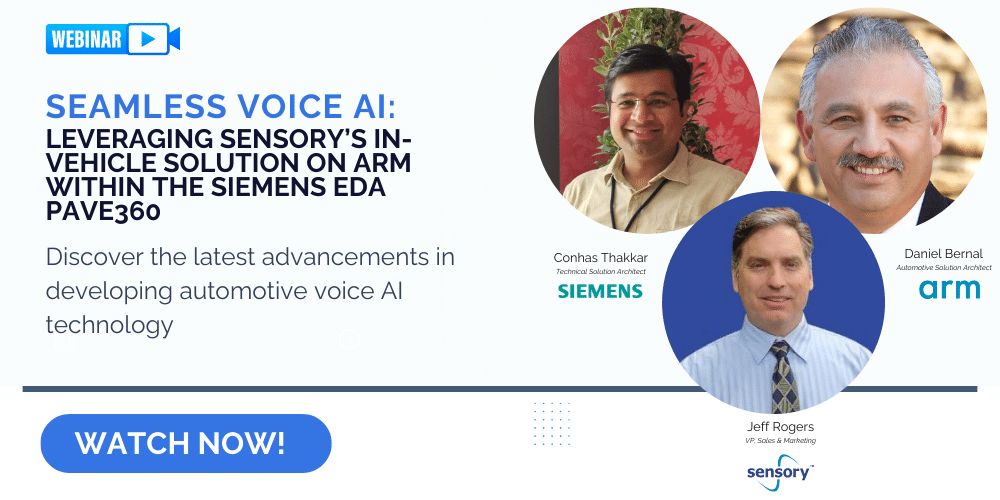In our recent webinar, industry leaders from Sensory, Siemens EDA, and ARM came together to discuss the latest advancements in automotive voice technology and their implications for security and innovation. The speakers included:
- Jeff Rogers, VP of Sales & Marketing at Sensory
- Conhas Thakkar, Technical Solution Architect at Siemens EDA
- Daniel Bernal, Automotive Solution Architect at Arm
Here’s a detailed recap of the key points and discussions:
Comprehensive In-Vehicle Solutions
The webinar started with an introduction to Sensory’s full voice and vision technology suite designed specifically for automotive applications. Our goal is to provide tier-one suppliers and OEMs with a complete in-vehicle assistant solution. This technology can operate entirely within the vehicle, eliminating the need for complex architectures that split functions between on-device and cloud-based systems.
Key Features and Capabilities
- Wake Words: Our solution supports multiple wake words, enabling seamless interaction with various in-car systems and external assistants like Siri, Alexa, Google, and LMS.
- Multilingual Support: With support for over 35 languages, our technology ensures accurate voice recognition across a global market.
- Automotive-Specific Language Models: These models are tailored to recognize and respond to commands specific to the automotive environment, ensuring precise and relevant interactions.
- Integrated NLU Models: Natural Language Understanding models help interpret and act on user commands effectively, streamlining the integration process for OEMs and tier-one suppliers.
Demonstrations
One of the highlights of the webinar was a series of live demonstrations showcasing the robustness and versatility of our voice technology.
- Voice Commands: Commands like “set the temperature to 68 degrees” and “navigate to the nearest gas station” were accurately recognized and executed, demonstrating the system’s reliability and user-friendliness.
- Voice-Activated Functions: Features such as adjusting wipers, turning off parking sensors, and accessing the driver’s manual for warning lights were smoothly controlled via voice commands.
- In-Vehicle Entertainment: Commands like “play Fleetwood Mac Rumors album on Spotify” illustrated the system’s integration with popular entertainment services, enhancing the in-car experience.
ARM’s Contribution to Software-Defined Vehicles
Daniel from ARM introduced their latest advancement, the Cortex A720 CPU, specifically designed for automotive applications. He highlighted how ARM’s virtual platforms enable software development and validation even before the silicon is available. This accelerates development timelines and supports the growing trend of software-defined vehicles. ARM’s involvement in the Sophie Consortium and the development of the WAL (Workload Abstraction and Orchestration Layer) further underscores their commitment to open industry standards and scalable solutions.
Siemens’ Play 360 Digital Twins
Conhas from Siemens discussed their Play 360 Digital Twins, which provide virtual hardware platforms for software development. This collaboration with ARM and AWS allows developers to begin creating applications in the cloud, independent of silicon availability. Siemens’ solution offers near-real-time simulation speeds, significantly faster than current technologies, and supports scalable and efficient software development.
Advanced Language Models and LMS Integration
The session concluded with exploring and integrating Large Language Models (LLMs) like ChatGPT into the automotive voice system. This integration allows for complex queries and interactions to be handled by LLMs, enhancing the functionality and user experience of in-car systems. Examples included finding restaurants, booking reservations, and retrieving vehicle-specific information, all facilitated by LLMs with minimal data transmission to the cloud, ensuring privacy and efficiency.
Watch the full webinar here, including live demos of Sensory’s in-vehicle solution on Arm within the Siemens EDA PAVE360. Download the slides here.
